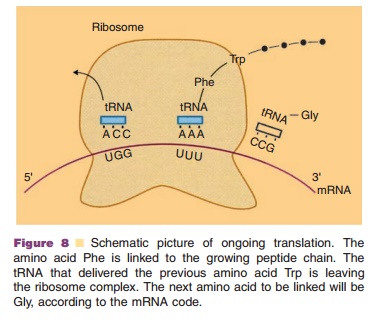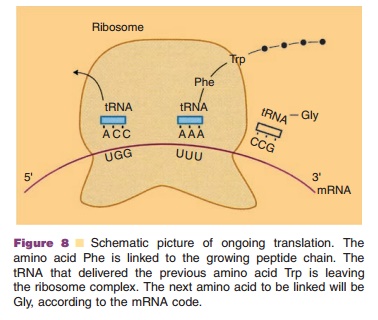Chapter: Pharmaceutical Biotechnology: Fundamentals and Applications : Molecular Biotechnology
Gene Translation

Translation
Translation,
presented schematically in Figure 8, is a complex cellular process where mRNA
molecules, ribosomes, tRNA molecules, amino acids, aminoacyl synthetases and a
number of translation factors act together in a highly coordinated way. The
ribosome, an organelle built from rRNA molecules and proteins, is the cellular
structure where the various compounds for the protein synthesis assemble.
The building elements of the proteins, the amino acids, are used in the protein synthesis in a form adapted for a convenient interaction with the mRNA. The adaptation of the amino acid is achieved by coupling it to a specific tRNA molecule through the catalytic action of specific aminoacyl synthetases. The adapted amino acid is linked to the 30-OH terminus of a specific tRNA molecule. Each tRNA molecule contains in a characteristic loop of the molecule a specific triplet. This triplet is complementary and runs antiparallel to the codon for the linked amino acid and is consequently designated the anticodon. Coupling through base pairing of the anticodon in the tRNA to the codon in the mRNA is the way amino acids are positioned according to the code in the mRNA.

Translation
starts with the formation of a specific initiation complex. In a bacterial cell
this consists of a 30S ribosomal subunit, a tRNA carrying the amino acid
methionine, GTP and various initiation factors all at the position of the start
codon AUG of the mRNA. To form this initiation complex the 50-end region of the bacterial
messenger is important. This region, which itself is not translated, harbors a
specific ribosome binding site. To the initiation complex a 50S ribosomal
subunit is subsequently bound, creating a functional 70S ribosome. Translation
then proceeds, with the help of specific elongation factors, in such a way that
the 70S ribosomes are transported along the mRNA molecule stepwise over a
distance of one triplet. This stepwise transport guarantees that protein
synthesis proceeds in a coordinated way dictated by the (triplet) codons. The
amino acids, delivered by the specific tRNA molecules, are linked together, one
after the other, by peptide bond formation. Meanwhile the tRNA carriers are set
free again.
At the
end of a mRNA molecule there are one or more stop codons. These triplets do not
accept any tRNA-aminoacyl molecule and are therefore terminat-ing signals for
protein synthesis. After termination the protein is released from the 70S
ribosome. The ribosomes then fall apart in their 30S and 50S subunits which may
be used in a further translation cycle.
Although
there is a common general picture for translation in prokaryotes and eukaryotes
there are nevertheless various distinct differences, especially in the nature
of initiation and elongation factors. A very clear distinction is a direct
consequence of the difference in DNA organization between pro- and eukaryotes.
In the prokaryotic cell, mRNA is already available for the ribosomes while it
is still in the process of transcription. In the eukaryotic cell, on the other
hand, the mRNA is only available for translation after it is completely
synthesized and after it is transported through the nuclear membrane.
Consequently, transcription and translation are coupled processes in the
prokaryotic cell, while these processes occur separately in the eukaryotic
cell.
Related Topics